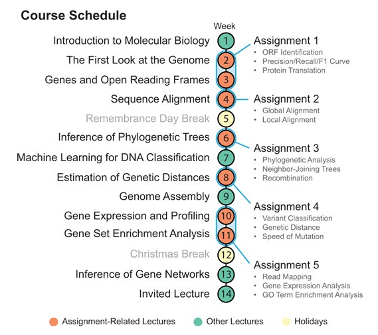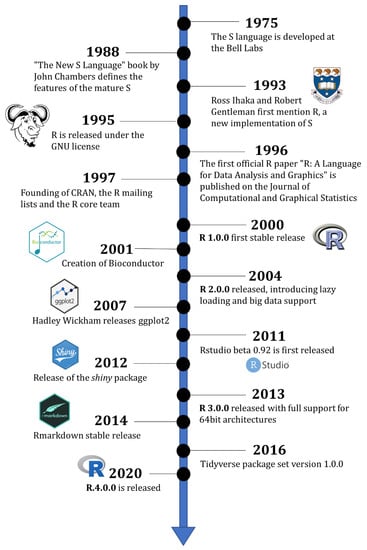8 Easy Facts About Bioinformatics Tutor Explained
8 Easy Facts About Bioinformatics Tutor Explained
Blog Article
Facts About Bioinformatics Tutor Revealed
Table of ContentsBioinformatics Tutor - An OverviewGetting The Bioinformatics Tutor To WorkBioinformatics Tutor Can Be Fun For EveryoneRumored Buzz on Bioinformatics TutorThe 7-Second Trick For Bioinformatics Tutor
Of the total individuals associated with the training, 80% were pupils from public college institutions, while the continuing to be 20% came from exclusive establishments. To get a certificate of involvement, trainees were required to go to a minimum of 90% of the overall training hours. As an outcome of this need, an excellent 95% of the participants successfully acquired their certifications, having not just met the minimum presence standards yet also finished all assigned tasks throughout the training.
During the elevation of the COVID-19 pandemic, especially between June and August 2020, the job team was entrusted with arranging specialized training in bioinformatics. This training was specifically targeted at trainees from the study group Nucleus for Research study in Applied Computing at the Federal College of Pará (UFRA) The adaptation to remote understanding systems as a result of the pandemic created an opportunity to check out new teaching methodologies and digital devices that improved both reach and effectiveness.
To respond to the expanding demand in the computing and life sciences areas, a sophisticated course was presented in 2020 labelled Intro to Artificial intelligence. This program was developed to give an obtainable yet thorough summary of Expert system methods, especially as used in bioinformatics. The program was executed over 3 months, from October to December 2020, and was supplied completely online with the Google Meet platform. This digital layout enabled involvement from pupils across Brazil, most of whom may not have had the chance to participate in in-person sessions.
Facts About Bioinformatics Tutor Revealed
A remarkable attribute of this program was its focus on hands-on learning. Roughly 50% of the complete training hours were dedicated to sensible activities where pupils developed smart models and applications in a series of scientific domain names, including genetics, molecular biology, and ecological data evaluation. Commonly used frameworks and tools such as Spyder, Google Colab, Jupyter Notebooks, and Orange were incorporated right into the coursework. These platforms allowed pupils to participate in real-time data adjustment, design training, and algorithm testing.
The course drew in 80 participants in overall. Sixty of them were affiliated with different college organizations in the state of Pará, while the remaining twenty came from establishments situated in 5 other Brazilian states. This wide geographical representation highlighted the national interest in bioinformatics and the growing need for specialized abilities in this field. By presenting Expert system in a functional and relevant context, the initiative served to connect the void between theory and real-world application, giving trainees with a solid structure for future research or work in the field.
The training effort developed component of a wider academic outreach effort referred to as the Bioinformatics when traveling task. This job has, for many years, presented dozens of trainees to the globe of bioinformatics and computational biology. The events held under this umbrella initiative have happened across numerous areas and years, as summarized in Table 1 (Listing of occasions, places, years, read the article and total varieties of trainees and teachers)
Numerous of these teams, originally brought together by their engagement in training occasions, have actually since gone on to produce independent scientific research in collaboration with local academic institutions. The training not only fostered scientific reasoning within the context of bioinformatics yet additionally triggered joint partnerships that expanded beyond the training setting.
Facts About Bioinformatics Tutor Uncovered
The task itself was conceived and arranged by megabytes and RR, that supervised the planning and execution of each step. Lectures were supplied by a multidisciplinary group including MB, FA, EF, KP, JS, get more DM, SN, LP, LG, IH, rr, and ac. The exact same team, excluding IH and RR, also acted as tutors for the useful training modules. Financing for the task was supplied through the give 88887.200562/ 2018-00 from CAPES. The writers prolong their gratefulness to everybody that added to the understanding of this project, whether directly or indirectly, considering that its beginning.
The Federal College of Pará's Workplace of Research study (PROPESP/UFPA) additionally offered financial backing, specifically for the manufacturing of the final manuscript. The authors declare no monetary or industrial conflicts of interest that could have influenced the research study. Additionally, all analyses and opinions expressed in this write-up are entirely those of the writers and do not always reflect those of their corresponding organizations, the author, editors, or reviewers entailed in the publication procedure.

All about Bioinformatics Tutor
From a pedagogical viewpoint, the mentor strategy used in the training was purposefully interactive. Classes were performed in a fashion that urged trainee involvement and conversation, going past rote memorization to discover exactly how ideas are developed, used in day-to-day live, and evaluated in scholastic settings. The training philosophy concentrated on supporting both solid and struggling students, providing individualized assistance, and structure self-confidence via continual mentorship and perseverance.

Each group, including roughly 36 participants, was supported by 3 advisors-- many of whom were postdoctoral researchers with customized experience. These mentors not just assisted make the group jobs however additionally facilitated their execution, guaranteeing that each research inquiry was both properly challenging and appropriate. The objective was to provide a naturally realistic context that participants could discover with flexible objectives and accessibility to curated datasets.
For added understandings into the methodology and results of this project-based understanding approach, readers are guided to S1 Text, which includes thorough summaries of the pedagogical structure, analysis approaches, and job styles utilized in the training sessions.
Bioinformatics Tutor Can Be Fun For Anyone
Of the total amount individuals involved in the training, 80% were trainees from public greater education and learning establishments, while the staying 20% came from private organizations. To certify for a certification of engagement, pupils were called for to go to at least 90% of the overall training hours. Significantly, past the students who enrolled in the training sessions, seven knowledgeable trainers participated in supplying the training courses, while three committed study teachers coordinated the total training process. Roughly 50% of the total training hours were committed to practical tasks where pupils constructed intelligent versions and applications in a variety of scientific domain names, consisting of genes, molecular biology, and ecological information analysis. The training not just promoted scientific reasoning within the context of bioinformatics however additionally sparked joint connections that prolonged beyond the training environment.
Report this page